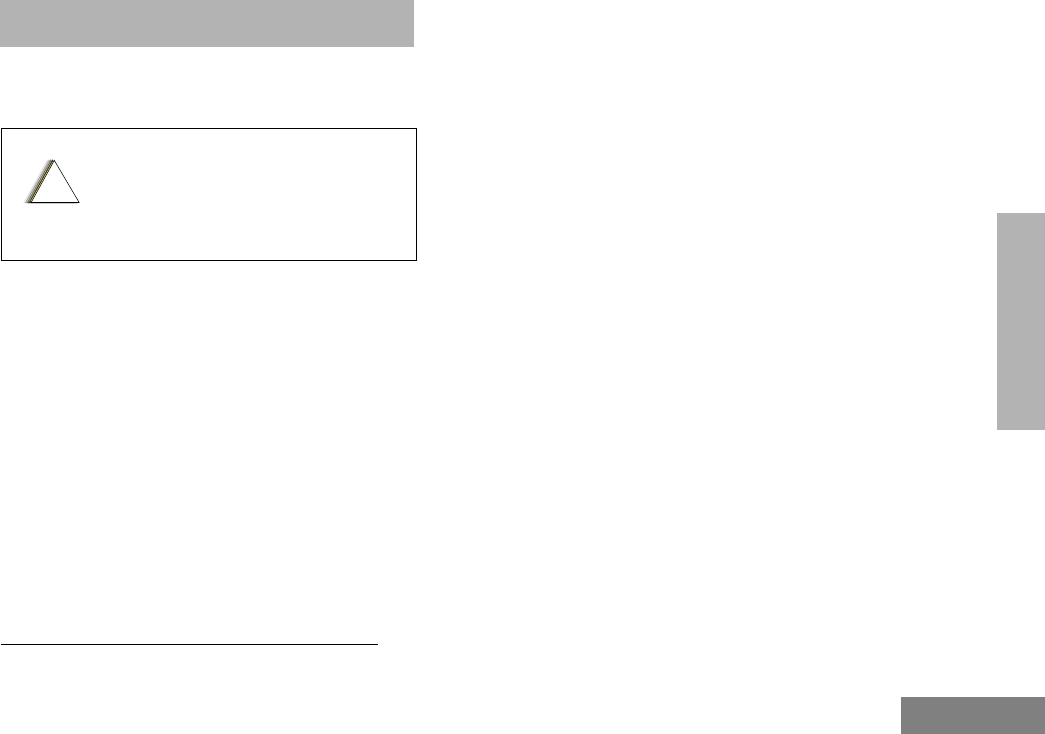User Guide
Table Of Contents
- CONTENTS
- Safety
- Introduction
- Radio Overview
- Getting Started
- Battery Information
- Accessory Information
- Turning your Radio On or Off
- Adjusting the Volume
- Selecting a Trunked Zone and Talkgroup
- Sending a Trunked Call
- Selecting a Conventional Zone and Channel
- Sending a Conventional Call
- Receiving a Trunked or Conventional Call
- Repeater or Talkaround J Mode
- Call Light
- (Trunked Operation Only)
- Home Channel Revert
- PassPort Trunking
- PassPort Signaling
- Radio Calls
- Scan
- Talkback
- PassPort Primary Auto Group Scan
- (PassPort Trunked Operation Only)
- PassPort Group Scan G
- (PassPort Trunked Operation Only)
- Auto Group Scan G
- (LTR Trunked Operation Only)
- All Group Scan G
- (LTR Trunked Operation Only)
- System Scan G
- (LTR Trunked and conventional Operation Only)
- Deleting a Nuisance Channel or Talkgroup
- Editing a Scan List
- View a Scan List
- Adding or Deleting Talkgroups or Channels in a Scan List
- Prioritizing a Talkgroup or Channel in a Scan List
- Phone
- Voice Storage
- Audio/Tone Settings
- Utilities
- Warranty
- Accessories
- 88C42-E_french.pdf
- Table des Matiéres
- Sécurité
- Introduction
- Aperçu de la radio
- Mise en route
- Informations sur la pile
- Informations sur les accessoires
- Activation ou désactivation de votre radio
- Réglage du volume
- Sélection d'une zone ou d'un groupe de conversation partagé
- Envoi d’un appel partagé
- Sélection d'une zone ou d'un canal conventionnel
- Envoi d’un appel conventionnel
- Réception d’un appel partagé ou d'un appel conventionnel
- Mode Relais ou Intercommunication J
- Voyant d’appel
- (Opération partagée seulement)
- Retour au canal d'origine
- Signalement PassPort
- Commutation PassPort
- Appels radio
- Appel sélectif
- Réception d’un Appel sélectif F
- Envoi d’un message Avis d’appel
- Réception d’un Avis d’appelF
- Verific. Radio
- Envoi d’un Message d’état
- Envoi d’un message
- Réception d’un message
- Envoi d'un signal d'urgence E
- (Modes conventionnel et LTR uniquement)
- Modification d’un répertoire de radios K
- Identification des noms et des tonalités d’appel
- Balayage
- Réponse
- Balayage automatique des groupes principaux PassPort
- (Opération partagée PassPort seulement)
- Balayage de groupes PassPort G
- (Opération partagée PassPort seulement)
- Balayage automatique de groupes G
- (Opérations partagées LTR seulement)
- Balayage automatique de tous les groupes G
- (Opérations partagées LTR seulement)
- Balayage du système G
- (opération partagée LTR et conventionnelle seulement)
- Suppression d’un canal ou d’un groupe de conversation importun
- Modification d’une liste de balayage
- Afficher une liste de balayage
- Ajout ou suppression de groupes de conversation ou de canaux dans une liste de balayage
- Classer par ordre de priorité un groupe ou un canal dans une liste de balayage
- Téléphone
- Messagerie vocale
- Paramètres audio/ tonalité
- Fonctions auxiliaires
- Garantie
- Accessoires

5
English
SAFETY
SAFETY
PRODUCT SAFETY AND RF
EXPOSURE COMPLIANCE
ATTENTION!
This radio is restricted to occupational use
only to satisfy FCC RF energy exposure
requirements. Before using this product, read
the RF energy awareness information and
operating instructions in the Product Safety
and RF Exposure booklet enclosed with your
radio (Motorola Publication part number
68P81095C98) to ensure compliance with RF
energy exposure limits.
For a list of Motorola-approved antennas,
batteries, and other accessories, visit the
following web site which lists approved
accessories:
http://www.motorola.com/cgiss/index.shtml
.
BATTERY INFORMATION
Charging Batteries
This product is powered by a nickel-cadmium
(NICd), nickel-metal-hydride (NiMH), or
lithium-ion rechargeable battery. Charge the
battery before use to ensure optimum capacity
and performance. The battery was designed
specifically to be used with a Motorola charger.
Charging in non-Motorola equipment may lead
to battery damage and void the battery
warranty.
Note: When charging a battery attached to a
radio, turn your radio off to ensure a full
charge.
The battery should be at about 77°F (25°C)
(room temperature), whenever possible.
Charging a cold battery (below 50°F [10°C])
may result in leakage of electrolyte and
ultimately in failure of the battery. Charging a
hot battery (above 95°F [35°C]) results in
reduced discharge capacity, affecting the
performance of your radio. Motorola rapid-rate
battery chargers contain a temperature-
sensing circuit to ensure that batteries are
charged within the temperature limits stated
above.
Before using this product, read
the operating instructions for safe
usage contained in the Product
Safety and RF Exposure booklet
enclosed with your radio.
!
C
a u t i o
n










